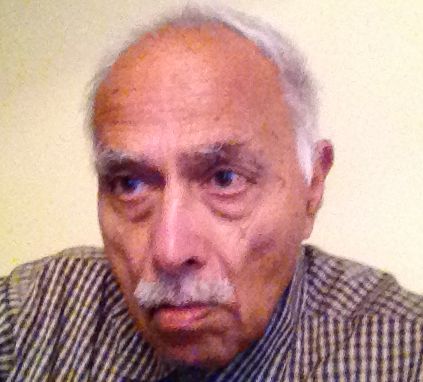A few visits to the Golden Temple at Amritsar
Category:
Tags:

Dr. Anand - an unholy person born in 1932 in the holy town of Nankana Sahib, central Punjab. A lawyer father, a doctor mother. Peripatetic childhood - almost gypsy style. Many schools. Many friends, ranging from a cobbler's son (poorly shod as the proverb goes) to a judge's son. MB from Glancy (now Government) Medical College Amritsar, 1958. Comet 4 to Heathrow, 1960.
Widower. Two children and their families keep an eye on him. He lives alone in a small house with a small garden. Very fat pigeons, occasional sparrows, finches green and gold drop in to the garden, pick a seed or two and fly away.
I was born in to a family that did not hold with priests of any sort, to put it mildly. In my childhood, we did not go on teeraths or yatras (religious trips). Nor did I ever hear teerathees approved of or criticised. These were people - other people - who did what suited them.
One of my grandmothers was always on the move through the length and breadth of Hindustan - as it was known then. She contributed her mite to the care-takers, or whatever they were called in the local lingo, of the mandirs (temples).
My mother used to recite JapJi, Sukhmani Sahib every day. My father used to read Sukhmani Sahib, printed in Farsi (Urdu script). I still have his copy, courtesy of my sister.
We did go to a local Gurdwara on religious occasions, and sometimes without a conscious reason.
The first time I went to the Golden Temple (Harmandir Sahib, Darbar Sahib) was when I was about ten years old, I think. My mother had gone to Amritsar for some course, and I went with her. A tonga took us to Darbar Sahib. At that time, it was not very crowded. The visitors, call them pilgrims if you like, seemed ordinary people, dressed mostly like Punjabees.
In those days, (1940s), Salwar Kameez was common to Hindus, Sikhs, Mussalmans in Pothohar (a plateau region in what is now Pakistan). Hindu men in that area also mostly wore a turban with a kulla. Some Hindus wore a round brown cap. Mussalmans wore a turban with a kulla. In Central Punjab, the Hindus wore, if anything, a brown cap, while the Mussalmans wore nothing on the head, or a turban with a kulla. Keshadhari Sikhs and many Hindus wore an ordinary turban.
Pyjamas were worn by Hindus and Sikhs, but never by Mussalmans.
All rural folk wore a Punjabi Jootie (type of shoe). Except that in Pothohar and further West, Peshawri Chappal was the invariable footwear.
There were some westernised men who wore a patloon (trousers) with a shirt. And a tie. And a hat. The hat in those days tended to be a khaki-coloured Solar topee.
What about the women? Christian women who were willing to stand out in a crowd wore skirts. Which reminds me: the Ghagra was worn by women in Southern Punjab, regardless of religion.
Few Muslim women in the Punjab wore Sarees. But, Hindu women frequently wore Sarees, and infrequently by Sikh women.
So, you could have a good guess at the origins and religious inclinations of the people by looking at their clothes.
In Darbar Sahib, in the early 1940s, the visitors were largely Slkhs and Hindus with some Mussalmans with their families. I learnt then that in many of these families there was a tradition through generations, of praying in Darbar Sahib, but not in any other gurdwara. I also learnt in my childhood but I cannot remember when, that the foundation stone of Darbar Sahib had been laid, at the request of the fifth Guru, by Mian Mir, a Muslim holy man.
There is a Mian Mir Chhaownee (station) near Lahore. Perhaps that is why Mian Mir is familiar to the locals. However, few Sikhs seem to know of Mian Mir's importance in Sikh history.
I learnt then also, the musicians of Darbar Sahib, had, generation after generation, served there.
They were Muslims.
This was a quick visit. We did not even have the time for a dip in the holy Pool (Sar).
My next visit was not until 1953, I think. From India, I had been on a visit to Pakistan, where I enjoyed Seekh Kebab in a glorious Dhaba called a hotel.
The owner/chef honoured us by seating us in the upstairs dining room. While I was eating, my eyes lit upon the opposite wall. I saw half a cow there! As a non-beef eater, I felt sick. I made my excuses, paid generously, and took the next train home. Arriving at Amritsar (Umbarsar, as we knew it colloquially), I practically ran to Durbar Sahib. There I had a dip, and prayed for absolution. Promised never to eat beef again. This promise lasted till 1960 when I did return to wicked ways.
In the late 1950s, when I studied at Glancy Medical College, Amritsar, I went frequently to Darbar Sahib. Perhaps three times a week. Sometimes I also partook of the Guru ka Langar. Maanh dee dal at the Langar was the tastiest I have ever eaten. On the road leading to Darbar Sahib, there was a dhaaba, where the Dal was equally tasty.
My last visit to Darbar Sahib was in January 1960. I had finished work at Safdarjang in Delhi. As final acts of goodbyes, I went to Amritsar, saw my brother and sister-in-law. Then I went to Durbar Sahib. Matha Taykia (bowing with your head touching the ground).
Took the train to Delhi. Listened to the advice of my uncle - dos and don'ts in land inhabited by the Goraas (white westerners).
A British Overseas Airways Comet IV flew me westwards. Unknowingly, I ordered Veal for my meal. Completely forgetting that I was going to eat a baby cow.
______________________________________
© Joginder Anand 2017
Comments
Add new comment